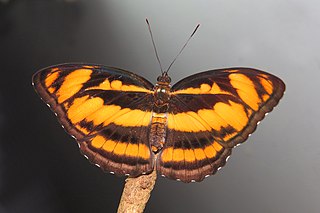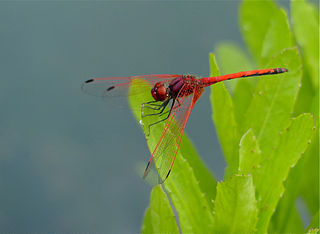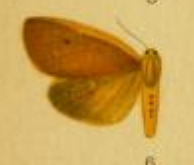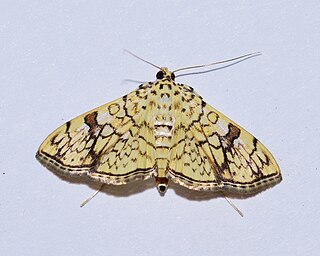
Cepora nadina, the lesser gull, is a small to medium-sized butterfly of the family Pieridae, that is, the yellows and whites. The species was first described by Hippolyte Lucas in 1852. It is native to Sri Lanka, India, Myanmar, Hainan, and southeast Asia.

Colotis danae, the crimson tip or scarlet tip, is a small butterfly of the family Pieridae, that is, the yellows and whites. It is found in Asia and Africa.

Curetis bulis, the bright sunbeam, is a species of butterfly belonging to the lycaenid family. It is found in Asia.

Athyma nefte, the colour sergeant, is a species of brush-footed butterfly found in tropical South and Southeast Asia.

Hippotion celerio, the vine hawk-moth or silver-striped hawk-moth, is a moth of the family Sphingidae. It was described by Carl Linnaeus in his 1758 10th edition of Systema Naturae.

Trithemis arteriosa, the red-veined dropwing, is a species of dragonfly in the family Libellulidae.

Corcobara is a monotypic moth genus of the family Erebidae first described by Frederic Moore in 1882. Its only species, Corcobara angulipennis, described by the same author in the same year, is found in India, Thailand, Cambodia, Myanmar, Malaysia, Indonesia, New Guinea, Sri Lanka and the Solomons.

Acraea natalica, the Natal acraea, is a butterfly of the family Nymphalidae, which is native to East and southern Africa.

Isodemis quadrata is a moth of the family Tortricidae. It is known from Tibet, China.

Oraesia emarginata is a species of moth of the family Erebidae first described by Johan Christian Fabricius in 1794. It is found in Australia, New Caledonia, Indonesia, New Guinea, Pakistan, the Philippines, India, Sri Lanka, Sulawesi, Taiwan, China, Japan, Korea and Nepal as well as Eritrea, Ethiopia, Kenya, Namibia, Nigeria, South Africa, Tanzania, the Gambia, Uganda, Oman and Yemen.

Acraea egina, the elegant acraea, is a species of butterfly in the family Nymphalidae with an extensive range in sub-Saharan Africa.

Acraea pentapolis, also known as the scarce tree-top acraea or eastern musanga acraea, is a butterfly in the family Nymphalidae. It is found in western and central Africa.

Acraea parrhasia, the yellow-veined acraea, is a butterfly in the family Nymphalidae which is native to sub-Saharan Africa.
Eilema punctifera is a moth of the subfamily Arctiinae first described by George Hampson in 1893. It is found in Sri Lanka.

Spilosoma gynephaea is a moth in the family Erebidae. It was described by George Hampson in 1901. It is found in South Africa and Zimbabwe.
Roxita adspersella is a moth in the family Crambidae. It was described by Pieter Cornelius Tobias Snellen in 1893. It is found in Sri Lanka.

Haritalodes polycymalis is a species of moth in the family Crambidae. It was described by George Hampson in 1912. It is found in sub-Saharan Africa from Sierra Leone to South Africa.
Drapetodes fratercula is a moth in the family Drepanidae. It was described by Frederic Moore in 1887. It is found in Sri Lanka, north-eastern Himalaya, Borneo, Bali, and Sulawesi.
Blera metcalfi, Metcalf's wood fly, is a rare species of syrphid fly first officially described by Curran in 1925 Hoverflies get their name from the ability to remain nearly motionless while in flight. The adults are also known as flower flies for they are commonly found around and on flowers from which they get both energy-giving nectar and protein rich pollen. The larvae are of the rat-tailed type feeding on exuding sap or in the rot holes of trees.

Brachyopa cynops , the Matt-tailed Sapeater, is a rare species of syrphid fly. It has been collected in Colorado. Hoverflies get their names from the ability to remain nearly motionless while in flight. The adults are also known as flower flies for they are commonly found around and on flowers, from which they get both energy-giving nectar and protein-rich pollen. Larvae for this genus are of the rat-tailed type. B.cynops larvae have not been described.














